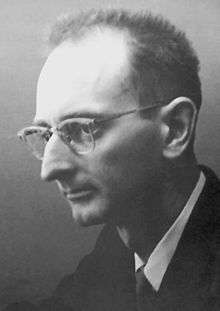Owen Chamberlain
| Owen Chamberlain | |
|---|---|
 | |
| Born |
July 10, 1920 San Francisco, California, USA |
| Died |
February 28, 2006 (aged 85) Berkeley, California, USA |
| Nationality | United States |
| Fields | Physics |
| Institutions | Los Alamos National Laboratory |
| Alma mater |
Dartmouth College University of California, Berkeley University of Chicago |
| Doctoral advisor | Enrico Fermi |
| Doctoral students | John Huth |
| Known for | Particle physics |
| Notable awards | Nobel Prize in Physics, 1959 |
Owen Chamberlain (July 10, 1920 – February 28, 2006) was an American physicist, and Nobel laureate in physics for his discovery, with collaborator Emilio Segrè, of the antiproton, a sub-atomic antiparticle.[1]
Biography
Born in San Francisco, California, Chamberlain graduated from Germantown Friends School in Philadelphia in 1937. He studied physics at Dartmouth College, where he was a member of Theta Chi Fraternity, and at the University of California, Berkeley. He remained in school until the start of World War II, and joined the Manhattan Project in 1942, where he worked with Segrè, both at Berkeley and in Los Alamos, New Mexico. He married Beatrice Babette Copper (d. 1988) in 1943, with whom he had four children.[2]
In 1946, after the war, Chamberlain continued with his doctoral studies at the University of Chicago under legendary physicist Enrico Fermi.[3] Fermi acted as an important guide and mentor for Chamberlain, encouraging him to leave behind the more prestigious theoretical physics for experimental physics, for which Chamberlain had a particular aptitude. Chamberlain officially received his Ph.D. from the University of Chicago in 1949.
In 1948, having completed his experimental work, Chamberlain returned to Berkeley as a member of its faculty, where he, Segrè, and other physicists investigated proton-proton scattering. In 1955, a series of proton scattering experiments at Berkeley's Bevatron led to the discovery of the anti-proton, a particle exactly like a proton except negatively charged. Chamberlain's later research work included the time projection chamber (TPC), and work at the Stanford Linear Accelerator Center (SLAC).
Chamberlain was also politically active on issues of peace and social justice, and outspoken against the Vietnam War. He was a member of Scientists for Sakharov, Orlov, and Shcharansky, three physicists of the former Soviet Union imprisoned for their political beliefs. In the 1980s, he helped found the nuclear freeze movement. In 2003 he was one of 22 Nobel Laureates who signed the Humanist Manifesto.[4]
Chamberlain was diagnosed with Parkinson's disease in 1985, and retired from teaching in 1989. He died of complications from the disease on February 28, 2006, in Berkeley at the age of 85.
Chamberlain plays a central role in Jacob M. Appel's Sherwood Anderson Award-winning short story, "Measures of Sorrow".[5]
Bibliography
- Chamberlain, Owen; Segre, Emilio; Wiegand, Clyde; Ypsilantis, Thomas, (October 1955). Observation of Antiprotons, Radiation Laboratory University of California predecessor to the Ernest Orlando Lawrence Berkeley National Laboratory (LBNL), United States Atomic Energy Commission predecessor to the U.S. Department of Energy.
- Chamberlain, Owen; Segre, Emilio; Wiegand, Clyde, (November 1955). Antiprotons, Radiation Laboratory University of California predecessor to the Ernest Orlando Lawrence Berkeley National Laboratory (LBNL), United States Atomic Energy Commission predecessor to the U.S. Department of Energy.
- Chamberlain, Owen; Keller, Donald V.; Mermond, Ronald; Segre, Emilio; Steiner, Herbert M.; Ypsilantis, Tom, (July 1957). Experiments on Antiprotons: Antiproton-Nucleon Cross Sections, Radiation Laboratory University of California predecessor to the Ernest Orlando Lawrence Berkeley National Laboratory (LBNL), United States Atomic Energy Commission predecessor to the U.S. Department of Energy.
- Chamberlain, O, (December 1959). The Early Antiproton Work (Nobel Lecture), Radiation Laboratory University of California predecessor to the Ernest Orlando Lawrence Berkeley National Laboratory (LBNL), United States Atomic Energy Commission predecessor to the U.S. Department of Energy.
- Chamberlain, O, (September 1984). Personal History of Nucleon Polarization Experiments, Lawrence Berkeley Laboratory (LBL) predecessor to the Ernest Orlando Lawrence Berkeley National Laboratory (LBNL), U.S. Department of Energy.
References
- ↑ Jaros, John; Nagamiya, Shoji; Steiner, Herbert (August 2006). "Obituary: Owen Chamberlain". Physics Today. 59 (8): 70–72. Bibcode:2006PhT....59h..70J. doi:10.1063/1.2349741.
- ↑ Sanders, Robert. Owen Chamberlain, Physics Nobelist, UC Berkeley professor, LBNL researcher and co-discoverer of the anti-proton, has died at 85. www.berkeley.edu (2006 March 1)
- ↑ Yarris, Lynn. Berkeley Scientific Great Owen Chamberlain Has Died. www.lbl.gov (2006 March 1)
- ↑ "Notable Signers". Humanism and Its Aspirations. American Humanist Association. Retrieved September 15, 2012.
- ↑ Appel, JM. Miracles and Conundrums of the Secondary Planets, Black Lawrence Press, 2015
External links
- Biography and Bibliographic Resources, from the Office of Scientific and Technical Information, United States Department of Energy
- Owen Chamberlain
- The Nobel Prize in Physics 1959
- Short Bio at Berkeley
- Guide to the Owen Chamberlain Papers at The Bancroft Library
- New York Times obituary
- National Academy of Sciences Biographical Memoir
